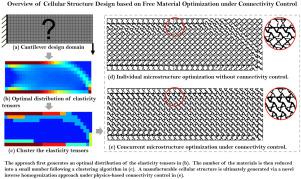Computer-Aided Design ( IF 3.0 ) Pub Date : 2020-05-08 , DOI: 10.1016/j.cad.2020.102854 Jingqiao Hu , Ming Li , Xingtong Yang , Shuming Gao

|
Cellular structures exhibit exceptional multifunction performance at relatively low densities and have wide industrial applications, but their effective design still remains challenging. The study aims to find a manufacturable cellular structure of valid geometry under certain volume usage budget, given a fixed design domain under external loadings. It is achieved via first introducing the concept of free material optimization (FMO), which provides an ultimately best structure among all possible elastic continua. After this, two novel control strategies are developed in combination with inverse homogenization to ultimately produce a cellular structure of valid geometric connectivity. It mainly includes approaches of material space reduction via hierarchical clustering, and a novel physics-based connectivity control to tailor the geometric connectivity between neighboring microstructures. Performance of the approach is tested on various 2D examples, in comparison with structures generated via classical (multiscale) topology optimization approaches.
中文翻译:

连通性控制下基于自由材料优化的蜂窝结构设计
蜂窝状结构在相对较低的密度下显示出出众的多功能性能,并具有广泛的工业应用,但是其有效的设计仍然具有挑战性。这项研究旨在在给定固定设计域,外部载荷的情况下,在一定的使用量预算下找到有效几何形状的可制造蜂窝结构。它是通过首先引入自由材料优化(FMO)概念来实现的,该概念在所有可能的弹性连续体中提供了最终最佳的结构。此后,结合反向均质化开发了两种新颖的控制策略,以最终产生有效几何连通性的细胞结构。它主要包括通过分层聚类减少物质空间的方法,以及一种新颖的基于物理学的连通性控制,以调整相邻微结构之间的几何连通性。与通过经典(多尺度)拓扑优化方法生成的结构相比,该方法的性能在各种2D实例上进行了测试。











































 京公网安备 11010802027423号
京公网安备 11010802027423号